This Sourdough Jamaican Coco Bread is a soft, fluffy, and slightly sweet half-moon-shaped coconut bun from Jamaica. These buns can also be found in the Caribbean.
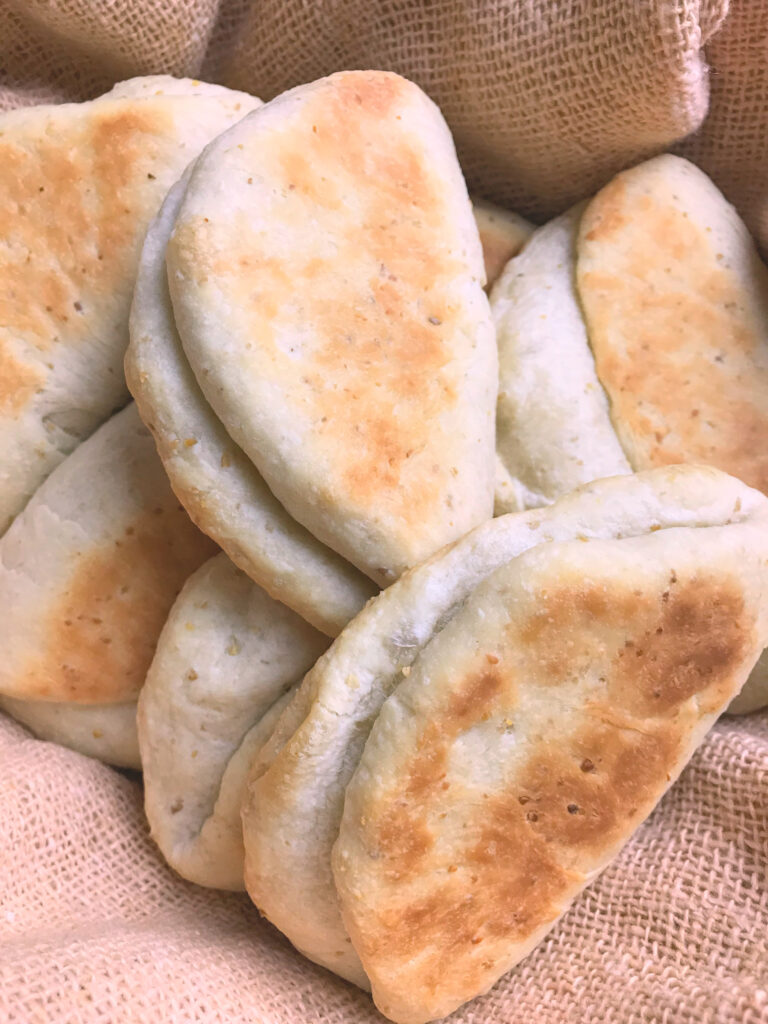
Coco Bread is made from a slightly sweet, yeasted, enriched soft, and elastic dough. These buns, with their characteristic folded shape, can be pulled open to make a sandwich, enjoyed on their own, or with vegetable or meat fillings. Jamaicans like these buns best stuffed with creamy cheddar cheese or a beef patty. Jamaican beef patties are flaky pastry pockets with spicy beef filling.
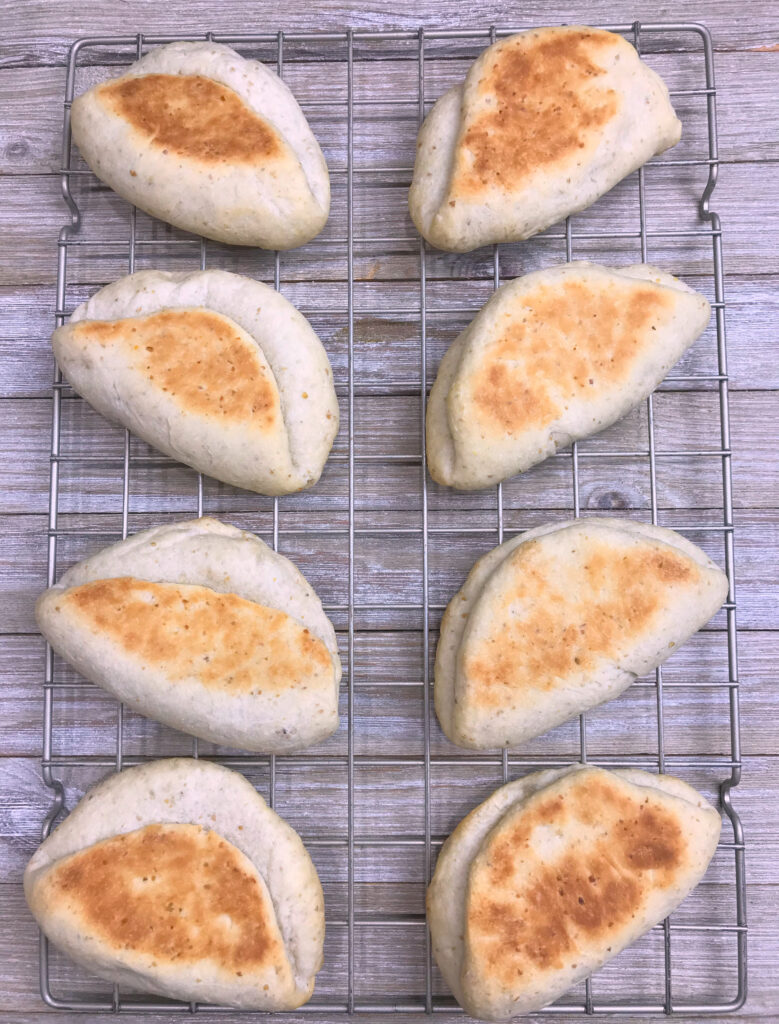
Using a sweet levain instead of yeast
Traditionally, Coco Bread is not meant to be sourdough due to the fluffy texture you typically get only by using yeast, but I decided to test that theory by using a sweet levain. I used ~20 percent of sweet levain in this recipe (20% x 400 grams of flour = 80 grams). It worked quite well.
As I mentioned in my post on Sourdough Japanese Salt Bread Shio Pan, using a sweet levain contributes to a more tender crumb, as the sugars in the sweet levain help to retain moisture, resulting in a softer, fluffier texture.
Additionally, the fermentation process with a sweet levain can improve the dough’s extensibility, making it easier to handle and shape. Finally, the sweet levain can also extend the bread’s shelf life by naturally preserving its freshness and softness for a longer period.
The type of coconut milk you use makes a difference
Aparna, the host kitchen this month for the Bread Baking Babes, mentioned you needed to use thick coconut milk for these buns.
The first time I made them, I couldn’t find thick coconut milk so I used a thinner coconut milk from a carton. The buns were fluffy and delicious but they didn’t brown very well.
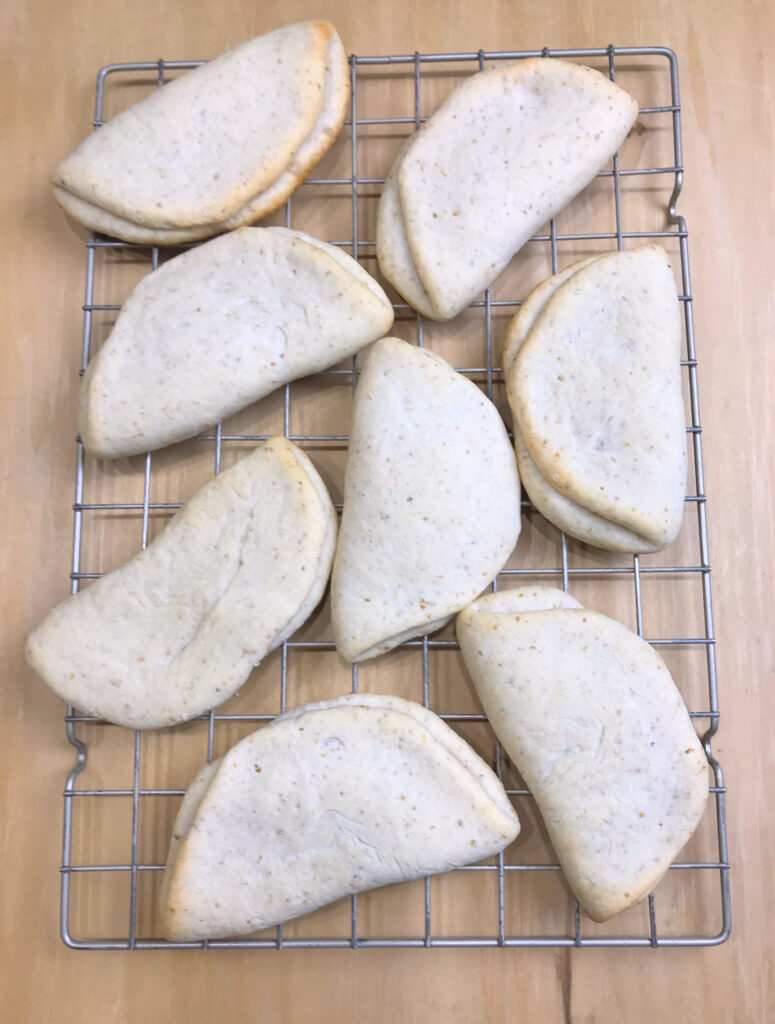
For the second batch, I used sweetened condensed coconut milk because I wasn’t paying attention when I bought it. I had to adjust the hydration, reduce the sugar, and ferment the dough a bit longer, but it still worked. The result was a delicious cookie-type bun. If you’re looking for a big cookie, I recommend these.
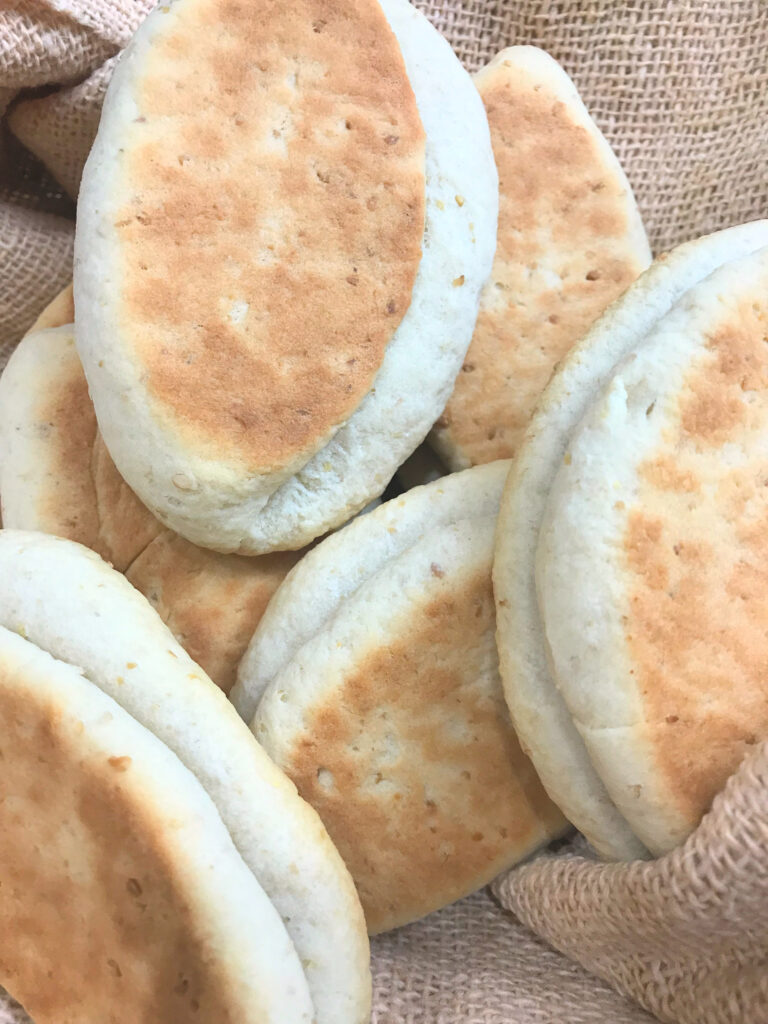
However, we were supposed to be making coconut buns so I decided to try again. This time, I used unsweetened coconut milk from a can, but not condensed milk. It was a beautiful dough to work with.
The third bake was the charm. I figured out the key to getting these buns to brown was to flip them over partway through baking.
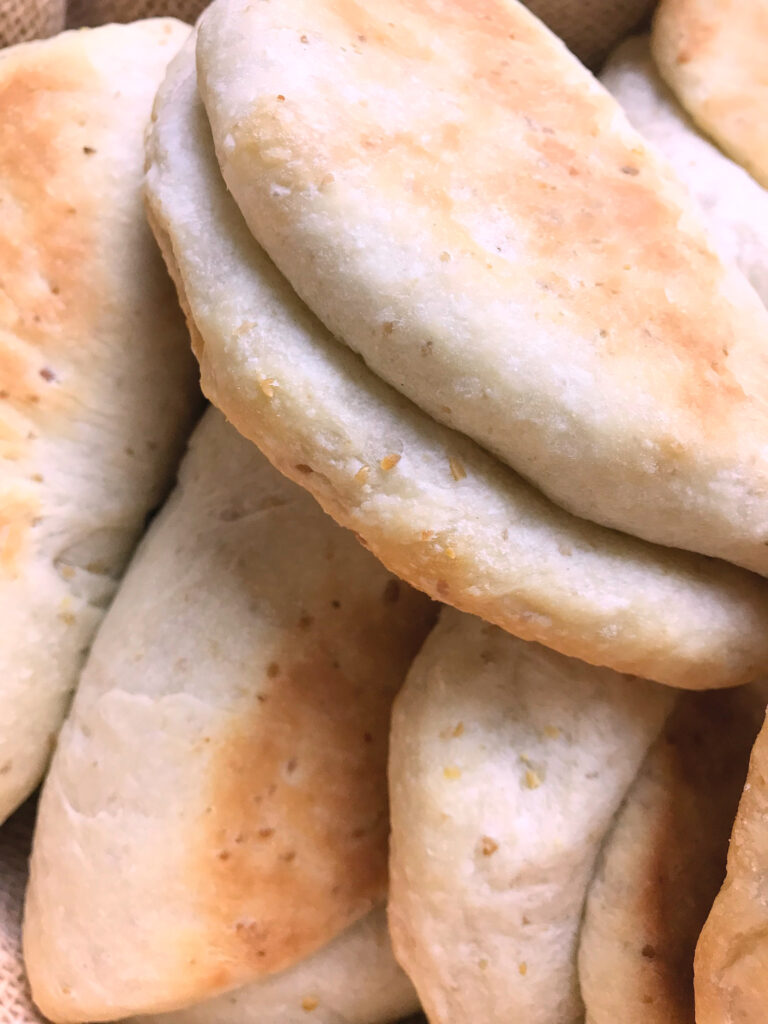
Useful Links:
https://www.youtube.com/shorts/-sircMdux_U
https://www.youtube.com/watch?v=kS4gnEDa-U0
The dough for these coco buns is proofed and then portioned and shaped into balls. Then, they are rolled out into 6-inch circles. A mixture of melted butter and coconut oil is brushed over the dough circles, and then they are folded over in half. This helps the folded flaps open easily for sandwiches. A little more of the butter-oil mixture is brushed on top of the folded buns and they’re allowed to rise for a short time before being baked till golden brown.
Sourdough Jamaican Coco Bread
- Yield: 8 Buns 1x
Description
This Sourdough Jamaican Coco Bread is a soft, fluffy, and slightly sweet half mooned shaped coconut bun from Jamaica. These buns can also be found in the Caribbean.
Ingredients
For the Sweet Levain:
- 30 grams all-purpose flour
- 30 grams water or coconut milk
- 20 grams sourdough starter, fed and active
- 2 grams (1/2 tsp.) granulated sugar
For the Dough:
- 345 grams all-purpose flour
- 15 grams flaxseed meal
- 200–225 grams lukewarm thick coconut milk
- Sweet Levain, all of the above
- 50 grams unsalted butter, softened
- 37 grams sugar
- 8 grams salt
For Brushing on the Dough:
- 25 grams unsalted butter, melted
- 25 grams coconut oil
Instructions
Sweet Levain:
In a small bowl, mix the sourdough starter, water or warm milk, flour and sugar until combined. Cover the bowl and let the mixture rise at warm room temperature until doubled in size, about 8-10 hours, depending on the temperature in your kitchen.
Final Dough:
In the bowl of a stand mixer, whisk the flour and flaxseed meal. Pour in the 200 grams coconut milk and mix to combine. If the dough seems dry, add 25 additional grams of coconut milk. Resist the urge to add more milk at this time. Cover and let rest for 30 minutes.
Add in the sweet levain and mix thoroughly to combine. Let rest 20 minutes.
Add in the softened butter and sugar and mix thoroughly. Let rest 20 minutes.
Add the salt and mix well. Continue mixing on low speed and then increase to medium speed until you achieve a soft, smooth and elastic dough that is no longer sticky. Add spoonsful of flour, water, or coconut milk if necessary to achieve this consistency. The dough should spring back slightly when you press it down gently.
Shape the dough into a ball and place in a bowl. Loosely cover the bowl with a damp kitchen towel and let it rest for 2-4 hours, depending on ambient temperature in your kitchen.
Perform a stretch and fold after the first 45 minutes and again after 1 ½ hours, if needed. Allow the dough to rest undisturbed for an additional 1 to 2 hours.
Mix together melted butter and coconut oil in a small bowl.
Lightly dust your countertop with flour and lightly knead the dough. Divide the dough into 8 equal portions. Shape each into a smooth ball and then roll out to 1/4-inch thick circles (about 6-inches in diameter), or thinner if you prefer. Brush the surface of the dough circles with the butter-oil mixture. Fold over exactly in half into half-moon shapes.
Place the folded dough on a lightly greased or parchment-lined baking sheet. Brush the tops of the folded dough with some more of the butter-oil mixture. You can also brush the tops of the folded dough with just melted butter or coconut milk if you prefer.
Loosely cover them and allow it to rise for about 30 to 40 minutes. Bake in a pre-heated oven at 180C (350F) for about 20-25 minutes, or till they’re golden brown and done. Let them cool on a wire rack. Serve slightly warm, plain, or as a sandwich, according to preference.
Notes
After the 2-3 hour bulk ferment, you can place the dough in the refrigerator to ferment overnight if this works better with your schedule. The next day, let it warm up to room temperature before shaping.
Halfway through baking, if the buns aren’t browning, flip them over then continue baking.
Storing:
These Coconut Buns are best eaten the day they are made, but they will keep for about 3 days at room temperature.
For longer-term storage, individually wrap the cooled breads in plastic wrap and freeze them to be thawed and reheated later.
Slightly stale coco bread can be freshened by reheating in a toaster oven at 350 degrees F for about 10 minutes. Or, reheat in the microwave for about 15 to 20 seconds.
- Category: Milk Bread
- Method: Sourdough
- Cuisine: Jamaican
Who are the Bread Baking Babes?
We are a group of breadbakers who get together every month and bake bread! We would love for you to bake Jamaican Coco Bread and share how it turned out and what you thought! Aparna, of My Diverse Kitchen, is the host kitchen this month.
Check out our Facebook group to see the participants’ baking results during that time. If you would like to post your results with a Buddy badge on a blog, let us know in the comments or on the Facebook page.
The Bread Baking Babes
My Diverse Kitchen – Aparna (host kitchen)
A Messy Kitchen – Kelly
Karen’s Kitchen Stories – Karen
Bread Experience – Cathy
Judy’s Gross Eats – Judy
blog from OUR kitchen – Elizabeth
Thyme for Cooking – Katie (roundup)
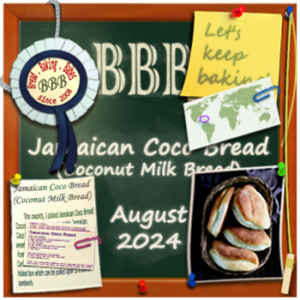
Happy Baking!
Cathy
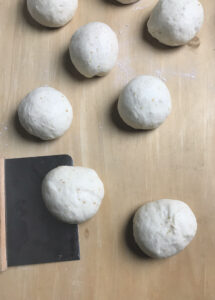
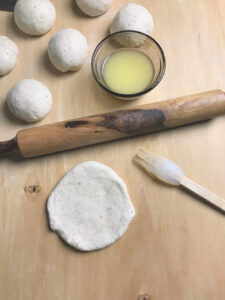
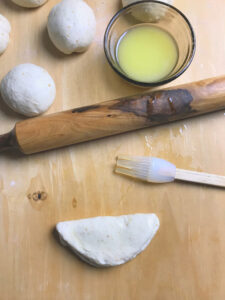
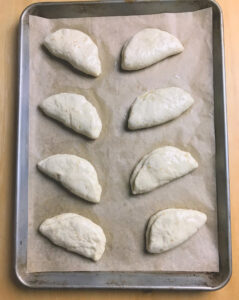
Karen's Kitchen Stories says
Yes, the baking time is not enough for browning. I went an extra 5 minutes. I admire your persistence!! These look great.
Cathy says
Thanks! I baked each batch for about 23-25 minutes. I baked them for 10 minutes on one side, flipped them over, then baked another 10 minutes, rotated the pan and baked another 3-5 minutes. Although they didn’t brown as well as I would’ve liked, they were very tasty.
Elizabeth says
Wow. I bow down to you. You got better loft with your sourdough starter than I did using commercial yeast!
I used insanely thick coconut milk because I misread the label on the tin; it was coconut cream. Next time, I will use coconut milk. I think that there is so much fat in coconut cream that the dough was quite reluctant to rise.
Cathy says
You’re too funny! It sounds like your coconut cream was similar to the condensed coconut milk I used for the 2nd batch. It was thick. The buns tasted great but they denser and crisper like a cookie. A yummy cookie but not a fluffy coconut bun.
Katie Zeller says
The last batch was beautiful!
Cathy says
Thanks Katie! They were tasty too!
Kelly says
Oh, thank you for reminding me that I have a can of sweetened condensed coconut milk that I should use up before it expires! I love the flecks from the flax seed, so pretty.
Cathy says
Thanks! Use the condensed coconut milk. It makes great cookies!
Judy says
Three batches! You are persistent, but it pays off by helping the rest us when choosing ingredients. I didn’t have to flip mine, so I think the egg helped with the color.
Cathy says
I’m thinking an egg wash might do the trick as well.